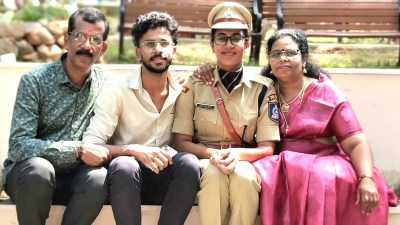Click here to join Express Pune WhatsApp channel and get a curated list of our stories
A tranquil Maratha memorial the state government is now trying to preserve
Visitors will be able to observe two memorials and a Mahadev temple, which are managed by Indore-based Devi Ahilyabai Holkar Charities Trust.
 The 18th-century Maratha-style architecture of the Chhatri and the temple reveal the era in which the monuments were constructed. (Photo: sahapedia.org)
The 18th-century Maratha-style architecture of the Chhatri and the temple reveal the era in which the monuments were constructed. (Photo: sahapedia.org)In a secluded corner of Khadki’s Cantonment area, the Holkar Chhatri is quietly camouflaged by a sprawling stretch of green and towering trees. An integral part of Maratha history and a symbol of the Holkar dynasty’s glory, this beautiful structure now sits deserted, its labyrinthine carvings and domes vulnerable to the passage of time. The site is a memorial of the Holkar family sardars.
Visitors will be able to observe two memorials and a Mahadev temple, which are managed by Indore-based Devi Ahilyabai Holkar Charities Trust.
In December 2024, the new Maharashtra state cabinet granted the Holkar Chhatri the status of a state-protected monument. The Directorate of Archaeology and Museums has been entrusted with putting up a draft notice beside the monument in both Marathi and English, which will be published in Part 4 of the state gazette. For history enthusiasts, the state initiative means that the monument will receive greater care in terms of preservation.
Campsite of the Sardars
“During the reign of Peshwa Bajirao I, Holkar and Shinde were two prominent subedars of the Maratha Empire. Shinde was assigned control of the Malwa region, including Ujjain, while the Holkars were granted the region of Indore. Later, both Sardars would frequently travel to Pune for their duties and camping. The Shindes were given the Wanowrie region, which is now known as the Mahadji Shinde Chhatri, while the Holkars were given lands near the banks of the Mula-Mutha River in Khadki to set up their camp,” says Pune-based historian Pandurang Balkawade.
He adds that Malhar Rao Holkar II, Tukhoji Holkar, and Vithoji Holkar used to reside here. “Ahilyabai Holkar also used to stay here. When the Maratha power weakened and the British took over, they established their cantonment at the sites of both these camping areas,” says Balkawde.
The 18th-century Maratha-style architecture of the Chhatri and the temple reveal the era in which the monuments were constructed. According to Sahapedia, which carried out an extensive mapping exercise of heritage in Pune, and other places across India, “Though it is known that the structure was established in 1730, it is unclear whom the memorial is dedicated to. Some records say that the chhatri (a dome-shaped pavilion) is in honour of Malhar Rao Holkar, an 18th-century Maratha nobleman from the ruling clan of Indore. Other records claim that the chhatri is dedicated to Malhar Rao’s younger brother, Sardar Vithoji Holkar, and his wife.”
Within the sanctum sanctorum of the complex’s Shiva temple are two pindis, or lingas, which are symbolic representations of Lord Shiva. These are thought to be dedicated to Vithoji and his wife, who carried out sati. A second samadhi in the compound is considered to be that of Lakhya Bargir, a valiant soldier of Malhar Rao.
A haunted heritage
To the north of the temple lies the 548-foot-long Holkar Bridge, spanning the Mula-Mutha River with its 19 arches and standing 33 feet above the riverbed. Constructed during the Maratha Empire in the 1800s, the bridge was later used by the British until they left in 1947.
It is marked by teak railings for support and a pedestrian walkway, connecting Khadki with Yerawada. According to several local accounts, the bridge is believed to be ‘haunted’ and has been a site of terrible deaths, including that of a child.
If there aren’t too many pedestrians on the bridge after dark, it is because of the stories of supernatural legends and the uneasiness that the old bridge is built above a 17th century cemetery.
Click here to join Express Pune WhatsApp channel and get a curated list of our stories







